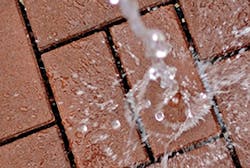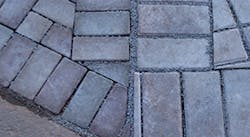Project Profile: Comparing Paver Performance at the University of Minnesota
Case studies often examine the potential problem-solving nature of products such as speed of installation, labor savings, and the like. But when it comes to performance, it is often expressed by contractors or building managers in terms of expectations for the future, thereby remaining a mystery as to how the product fared months or even years later. In this case, however, a paver project was recently revisited six years after the pavers were installed and tested side-by-side with traditional concrete pavers.
The University of Minnesota Duluth (UMD) had selected AZEK permeable pavers for a project six years ago. The difference of these recycled-content alternatives compared to traditional concrete pavers is clearly visible: no signs of cracks and minimal wear and tear, damage, and color change. The concrete pavers installed at the same time, however, had buckled and raised up on one side, showing cracks and wear.
UMD’s need for a permeable solution came about when the university was constructing a new civil engineering building and wrestled with how to manage stormwater runoff on impervious surfaces around the building; the campus is located on a designated trout stream that drains into Lake Superior. The university’s stormwater pollution prevention program required stormwater treatment, and the designer suggested AZEK permeable pavers for their water infiltration properties (made possible by spacer lugs on the sides of the pavers) up to 95% recycled content. The pavers are composed mostly of scrap auto tires, along with some plastics, and make it easier to attain LEED points than traditional pavers. In fact, AZEK pavers’ manufacturing to date has diverted more than 10 million pounds of scrap rubber and plastics from US landfills, using recycled material from more than 535,000 scrap tires and 16 million plastic food containers and DVD cases. The manufacturing process also uses 95% less energy and produces 96% less in carbon dioxide (CO2) emissions than conventional pavers.
The big question was how they would perform in sub-freezing Minnesota temperatures, with repeated freeze-thaw cycles, the scraping of snow plows, the snow itself, and the salt used for deicing. Top it off with heavy truck traffic in a loading dock area and it presented an all-out challenge for a new paver technology versus the traditional pavers. Another question was how AZEK pavers would manage the rainwater runoff.
According to Mindy Granley, UMD’s sustainability coordinator, the area’s soil has a high clay content and is not conducive to absorbing water. “Rainwater from the campus can get down from the top of the hill to Lake Superior in just 10 to 15 minutes,” she says. She points out that impervious surfaces can affect water quality and that by controlling the volume and speed of the water flow, pollution and erosion are reduced.
The AZEK paver versus concrete paver test was set up in two high-traffic areas. The first was a 600-square-foot loading and storage area, an expansion of UMD’s plumbing shop where truck deliveries are made. Erik Larson, an engineer at UMD, explains that this was an appropriate test area because it had poor drainage and was frequently muddy after heavy rains; it receives vehicle, forklift, and truck traffic. Set into their 16- by 16-inch interlocking grids, AZEK permeable pavers were installed next to traditional concrete pavers on the same engineered base.
The second area was a 75-square-foot triangular area outside UMD’s Sports and Health Center, where the unloading of sports teams and student foot traffic took a toll on the ground. Despite attempts by the Building and Grounds Division of Facilities Management to landscape the space, students kept cutting through it. It provided a good proving ground to see how the new permeable pavers handled foot traffic in winter conditions.
After a tough Minnesota winter in spring 2008, UMD deemed the test to be favorable for the permeable pavers. Unlike concrete in theSix years later, UMD is still encouraged by the new pavers’ performance in all three locations. Whereas the concrete pavers took more of a beating from traffic and snow and ice control, AZEK permeable pavers look more like the day they were installed.
According to Granley, they have proven to be an effective solution to UMD’s soil conditions as well as standing up to extreme winter conditions–both natural and manmade. Larson agrees, adding, “We do intend to use the pavers on future projects.”
In the fall of 2007, when UMD tested the new paver technology against traditional concrete pavers, the product was a recent invention, available only regionally and through architect specification. In fall 2011, VAST Enterprises entered a strategic alliance with AZEK Building Products, known for its low-maintenance line of premium exterior building products. In December 2012, AZEK bought out the company, and AZEK pavers are now available nationally through lumber dealers that carry AZEK products, greatly expanding the market for the pavers.




